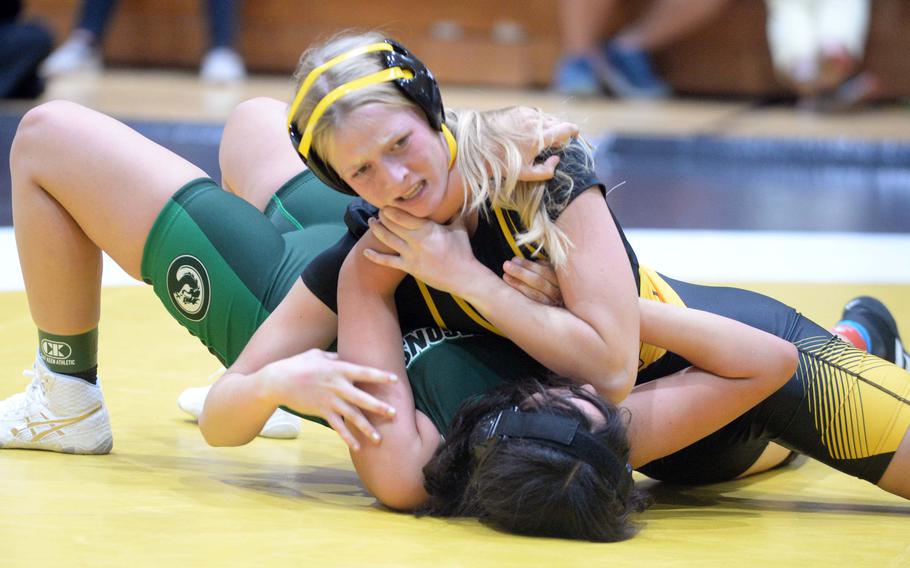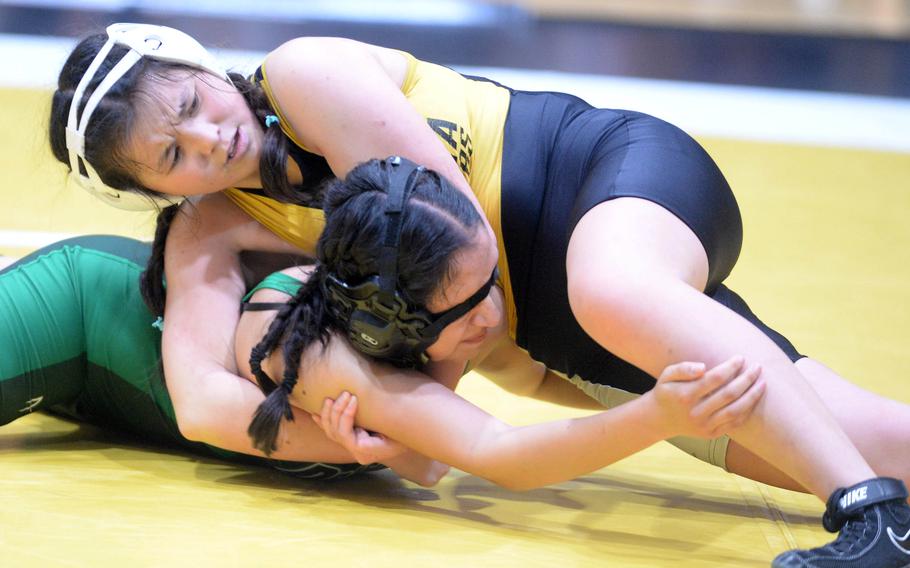
Kadena’s Brooke Brewer pinned Kubasaki’s Esmeralda Menoles in 2 minutes, 2 seconds at 145 pounds. (Dave Ornauer/Stars and Stripes)
KADENA AIR BASE, Okinawa – Brooke Brewer arrived at Kadena two school years ago already well versed in soccer.
Last month, two years of tennis practice paid off when she captured the Okinawa district girls singles tournament title.
And there she was Wednesday, on a wrestling mat before a raucous, vocal home crowd cheering her on as the Panthers junior won her varsity debut by pin over Kubasaki’s Esmeralda Menoles in the 145-pound weight class.
“I know Coach (Joey) Wood,” Brewer said of the man who also coached her the last two years in girls soccer. “I thought it would be good conditioning for soccer.”
It was also a chance for her and 12 other Kadena girls and 13 from Kubasaki to make history. They became the first official high school-sponsored girls wrestling teams to compete in a DODEA-Pacific meet.
“Webster’s doesn’t have words to describe the opportunities these girls have,” Dragons coach David Wray said. “This is something the girls have been itching for, to be provided that opportunity.”
Wood wrestled in the mid-2000s for Nile C. Kinnick and had seen girls trying to crack the rank-and-file boys teams with limited success.
“I’ve always seen girls in the sport, but they’ve always been at a disadvantage” from a standpoint of strength and physicality, Wood said. “It’s good to see the sport moving in the right direction.”
DODEA schools in Europe begin a full-fledged girls wrestling season in December. DODEA-Pacific opted in October to launch a pilot program featuring the two Far East schools with the highest enrollments and the most girls who’ve wrestled in previous seasons, DODEA-Pacific officials said.
DODEA-Okinawa district superintendent – and former Kadena wrestler – Craig Maxey presented a proposal that was given the nod by DODEA-Pacific “to gauge interest and see where it leads,” DODEA-Pacific athletics coordinator Tom McKinney said.
“I know (Kadena and Kubasaki) are still adding numbers,” McKinney said. “They’re seeing it’s there. We’re going to continue to encourage it and keep growing it.”
It is believed that Robert D. Edgren was the first DODEA-Pacific high school to put a girl on the mat. Janine Kunsch wrestled at 122 pounds for the Eagles in the 1998-99 season.
Growth has been gradual over the years, but on occasion, a girl wrestler has reached the top rungs of a particular weight class. Three have placed in Far East tournaments, the most recent being Kubasaki’s Gwen Pantaleon taking third in Far East two years ago.
The 2023-24 season saw 56 girls wrestling for teams in Japan and Okinawa, twice as many the previous season, “and I don’t see it slowing down,” said Bryan Koslow, the father of three former Far East boys champions with St. Mary’s. His daughter, Serena, is a junior wrestling for American School In Japan.
ASIJ and Seisen each have full girls teams.
For the first time, the Pacific region’s largest in-season tournament, the “Beast of the Far East” scheduled for Jan. 11 at St. Mary’s, will feature a girls division.
The same won’t happen at this year’s Far East, McKinney said. As far as the 2025-26 school year, “it depends,” he said.
Multiple media outlets call girls wrestling the fastest growing sport in the United States.
Hawaii was the first to sanction high school girls wrestling in 1998 and since then, the number of states has grown to 45, according to TheMat.com, USA Wrestling’s official newsletter. Guam high schools have had girls wrestling as a separate sport for more than 20 years.
“Numbers are growing fast,” said Jay Fabunan, Zama Class of 2002 who wrestled for the Trojans and coached girls wrestling at two California high schools before becoming assistant principal at Sweetwater High.
“The interest is there. Build it and they will come,” Fabunan said, adding that girls wrestling is what “saved the sport. It was dying for a while, and now interest is back up for boys, too.”
Women’s college wrestling is conducted under international freestyle rules “and it’s an offseason sport here, so girls who wrestle it in Japan can get a lot of opportunities if they do well,” Fabunan said.
“They don’t have to make a transition” from freestyle to folkstyle – as boys do – when girls move from DODEA-Pacific to college to wrestle, “which is really cool,” Wood said.
Only three DODEA-Pacific schools have demonstrated they have the numbers to field full or almost-full girls teams at this point: Kadena, Kubasaki and Nile C. Kinnick.
The Red Devils began the season with 20 girls and now have 10 as the season is unfolding, coach Stan Hovell said.
Humphreys, the largest DODEA-Korea high school in terms of enrollment, only had two girls in the practice room earlier this month.
Still, “it can work,” Blackhawks sixth-year coach Ben Pak said. “If the opportunity is offered, we could have 12 girls or more. I think it’s time. It won’t happen here this year, but it could next year.”
At smaller schools such as Daegu, with an enrollment of just 112, it might not be possible, Warriors second-year coach Zach Colflesh said.
“With our school population, I don’t think we can have a girls team,” he said. “One or two, yes, but not a full squad.”
Yokota third-year coach Theo Kuntz recruited heavily last school year and got only two girls in the practice room. This year, he said he didn’t say much and yet seven came out, including senior Zaylee Gubler, who wrestled as a sophomore but took last season off.
“It would be amazing” to have a girls division at Far East, Gubler said. “It would benefit everybody. Girls can get a good comparison of their skills against like opponents, instead of getting beat up regularly by boys.”
The bottom line is offering the opportunity and that opportunity spreading by word of mouth, Kuntz said. “It takes having people in it and those people encouraging others to do it,” he said.

Kadena's Mia Espiritu won by technical fall over Kubasaki's Aiyana Oldham 14-4 in 3:31 at 131 pounds. (Dave Ornauer/Stars and Stripes)